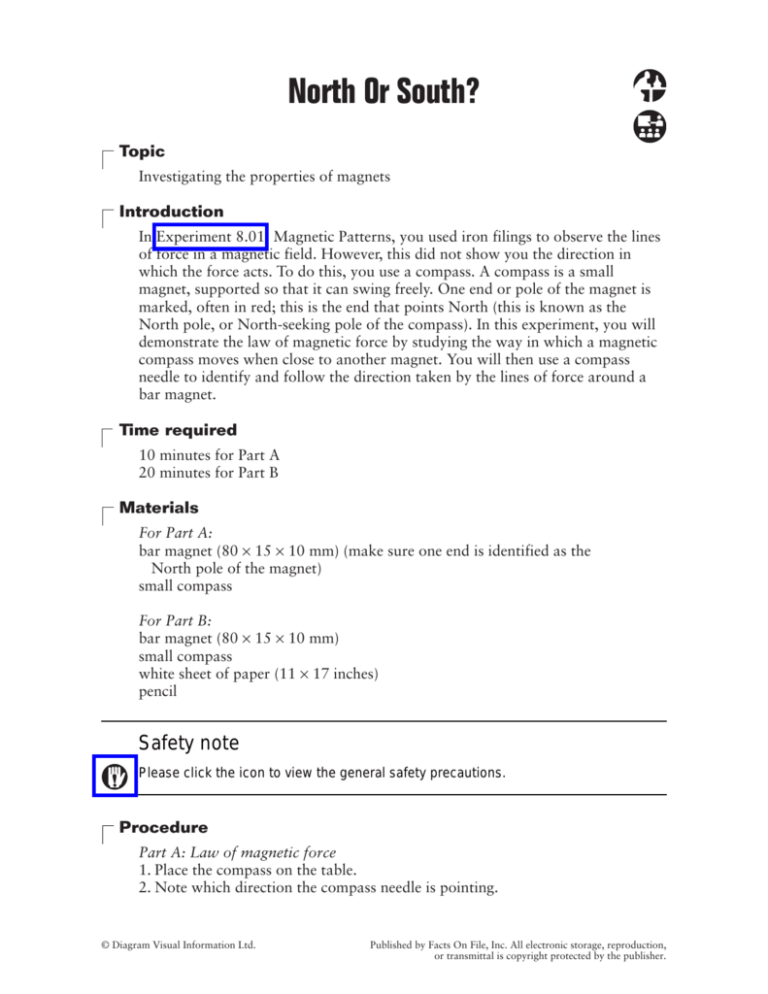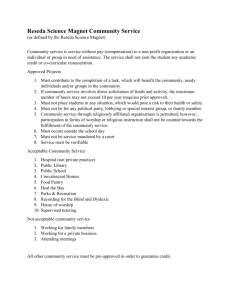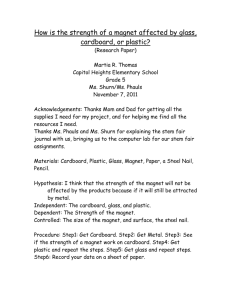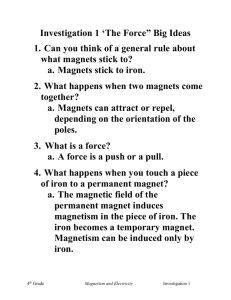*Chap 08 (22 plates)
advertisement

North Or South? Topic Investigating the properties of magnets Introduction In Experiment 8.01: Magnetic Patterns, you used iron filings to observe the lines of force in a magnetic field. However, this did not show you the direction in which the force acts. To do this, you use a compass. A compass is a small magnet, supported so that it can swing freely. One end or pole of the magnet is marked, often in red; this is the end that points North (this is known as the North pole, or North-seeking pole of the compass). In this experiment, you will demonstrate the law of magnetic force by studying the way in which a magnetic compass moves when close to another magnet. You will then use a compass needle to identify and follow the direction taken by the lines of force around a bar magnet. Time required 10 minutes for Part A 20 minutes for Part B Materials For Part A: bar magnet (80 × 15 × 10 mm) (make sure one end is identified as the North pole of the magnet) small compass For Part B: bar magnet (80 × 15 × 10 mm) small compass white sheet of paper (11 × 17 inches) pencil Safety note Please click the icon to view the general safety precautions. Procedure Part A: Law of magnetic force 1. Place the compass on the table. 2. Note which direction the compass needle is pointing. © Diagram Visual Information Ltd. Published by Facts On File, Inc. All electronic storage, reproduction, or transmittal is copyright protected by the publisher. 3. Observe the movement of the compass needle while moving the North pole of the bar magnet: a. close to the North pole of the compass b. close to the South pole of the compass c. close to each side of the compass. Record your observations in the data table below. 4. Repeat step 3, but moving the South pole of the magnet. DATA Action TABLE Observations Moving the North pole of the magnet Moving the South pole of the magnet Part B: Plotting the direction of the lines of force around a bar magnet 1. Place the sheet of paper flat on the table or bench. Place the bar magnet in the center of the sheet of paper. 2. Trace around the bar magnet using the pencil. 3. Make a pencil mark at one end of the magnet (see diagram 1 below). point from which to start plotting a line of force 1 Starting point for plotting the lines of force 4. Take the compass and position one end of the compass needle at the pencil mark (see diagram 2 below). pole of compass on original mark 2 new mark made Position of compass needle and bar magnet 5. Make a dot with the pencil to mark the position of the end of the compass needle facing away from the magnet (see diagram 2 above). © Diagram Visual Information Ltd. Published by Facts On File, Inc. All electronic storage, reproduction, or transmittal is copyright protected by the publisher. 6. Move the compass away from the magnet to a position where the end nearer to magnet is over the dot made in step 5. 7. Make a dot marking the position of the end of the compass needle facing away from the magnet (see diagram 3 below). 8. Repeat steps 6 and 7 until reaching the edge of the paper or, for some starting positions (see step 10 below), until reaching the magnet again. pole of compass on second mark made 3 third mark Moving the compass away from the bar magnet 9. Make a line by connecting the dots. On the line, place an arrow indicating which end of the compass needle was pointing North (see diagram 4 below). 10. Starting at different points around the magnet, repeat steps 3 to 9 to build up a picture of the lines of force around the magnet. 4 Connected dots making a line of force Analysis Part A: Law of magnetic force 1. What direction did the compass point in the absence of the magnet? 2. When moving the North pole of the magnet towards the compass, in which direction did the compass needle move? 3. When moving the South pole of the magnet towards the compass, in which direction did the compass needle move? 4. What can you deduce about the attraction and repulsion of magnets? Part B: Plotting the direction of the lines of force around a bar magnet 1. How does the shape of the lines drawn in step 10 compare with the patterns made by the iron filings in Experiment 8.01: Magnet Patterns? 2. What is the significance of the arrows on the lines? Want to know more? Click here to view our findings. © Diagram Visual Information Ltd. Published by Facts On File, Inc. All electronic storage, reproduction, or transmittal is copyright protected by the publisher. PHYSICS EXPERIMENTS ON FILETM OUR FINDINGS • 10.36 8.02 North Or South? Part A: Law of magnetic force 1. The needle magnet pointed North in the absence of the magnet. This is because the Earth has a magnetic field – it is like a huge bar magnet with one pole near what we call the North Pole and the other near what we call the South Pole. (The “pole” of the magnet at the North Pole is actually a South pole; the North pole of compass magnets are attracted to it.) 2. The compass needle moved so that its North pole was pointing away from the magnet. 3. The compass needle moved so that its North pole was pointing towards the magnet. 4. Like poles of magnets repel each other and unlike poles attract each other. This is the law of magnetic force. Part B: Plotting the direction of the lines of force around a bar magnet S N North pole of magnet 1. The lines drawn made the same pattern as the iron filings (see diagram above). 2. The arrows show the direction in which a North pole would move at a particular position in the field. This shows the direction in which the magnetic force acts. At different positions around the magnet, the lines spread out and come together. If the lines are close together, it shows that the strength of the magnetic field is greater at that point. The magnetic field of the bar magnet affects the compass even though it is not touching it. In the same way, you can remove a piece of metal from a glass of water without getting wet hands. To do this, place an object made of iron or steel in a glass of water, hold a magnet to the side of the glass, and slowly raise the magnet up the side of the glass to the top. The piece of metal will be affected by the force of the magnet and will rise to the top of the glass. This is an example of a force acting at a distance in this way; many forces have to be in contact with the object being moved. 8.03 Magnetic Influence – Temporary And Permanent 1. The iron filings did not move. The bar is not magnetized and so there is no force to attract the filings. 2. Very few filings stuck to the end of the bar. This may be because the bar is still very slightly magnetized, or because some of the filings are magnetized. © Diagram Visual Information Ltd. Published by Facts On File, Inc. All electronic storage, reproduction, or transmittal is copyright protected by the publisher. Special Safety Note To Experimenters Each experiment includes any special safety precautions that are relevant to that particular project. These do not include all of the basic safety precautions that are necessary whenever you are working on a scientific experiment. For this reason, it is absolutely necessary that you read, copy, and remain mindful of the General Safety Precautions that follow this note. Experimental science can be dangerous, and good laboratory procedure always includes carefully following basic safety rules. Things can happen very quickly while you are performing an experiment. Things can spill, break, even catch fire. There will be no time after the fact to protect yourself. Be prepared for unexpected dangers by following basic safety guidelines the entire time you are performing the experiment, whether or not something seems dangerous to you at a given moment. We have been quite sparing in prescribing safety precautions for the individual experiments. We made this choice for one reason: We want you to take very seriously every safety precaution that is printed in this book. If you see it written here, you can be sure that it is here because it is absolutely critical to your safety. One further note: The volume assumes that you will read the safety precautions that follow, as well as those in the box within each experiment you are preparing to perform, and that you will remember them. Except in rare instances, these precautions will not be repeated in the procedure itself. It is up to you to use your good judgment and pay attention when performing potentially dangerous parts of the procedure. Just because the book does not say BE CAREFUL WITH HOT LIQUIDS or DON’T CUT YOURSELF WITH THE KNIFE does not mean that you should be careless when simmering water or stripping an electrical wire. It does mean that when you see a special note to be careful, it is extremely important that you pay attention to it. If you ever have a question about whether a procedure or material is dangerous, wait to perform it until you find out for sure that it is safe. GENERAL SAFETY PRECAUTIONS Accidents caused by carelessness, haste, insufficient knowledge, or taking unnecessary risks, can be avoided by practicing safety procedures and being alert while conducting experiments. Be sure to check the individual experiments in this book for additional safety regulations and adult supervision requirements. If you will be working in a lab, do not work alone. PREPARING: —Clear all surfaces before beginning experiments —Read the instructions before you start —Know the hazards of the experiments and anticipate dangers PROTECTING YOURSELF: —Follow the directions step-by-step; only do one experiment at a time —Locate exits, fire blanket and extinguisher, gas and electricity shut-offs, eyewash, and first-aid kit —Make sure there is adequate ventilation —Act sensibly at all times —Wear an apron and safety glasses —Do not wear open shoes, loose clothing, or loose hair —Keep floor and workspace neat, clean, and dry —Clean up spills immediately, being careful to follow the recommended procedure for dealing with the split substance —Never eat, drink, or smoke in the laboratory or workspace —Do not eat or drink any substances tested unless expressly permitted to do so by a knowledgeable adult © Diagram Visual Information Ltd. Published by Facts On File, Inc. All electronic storage, reproduction, or transmittal is copyright protected by the publisher. USING EQUIPMENT WITH CARE: —Set up apparatus far from the edge of the desk —Use knives and other sharp or pointed instruments with caution —Pull plugs, not cords, when removing electrical plugs —Don’t use your mouth to pipette liquids; use a suction bulb —Check glassware is clean and dry before use —Check glassware for scratches, cracks, and sharp edges —Report broken glassware immediately so that it can be cleaned up by a responsible person —Do not use reflected sunlight to illuminate your microscope —Do not touch metal conductors —Use only low voltage and current materials such as lantern batteries —Be careful when using stepstools, chairs, and ladders USING CHEMICALS: —Never taste or inhale chemicals —Label all bottles and apparatus containing chemicals —Read labels carefully —Avoid chemical contact with skin and eyes (wear safety glasses, lab apron, and gloves) —Do not touch chemical solutions —Wash hands before and after using solutions —Wipe up spills thoroughly HEATING SUBSTANCES: —Wear safety glasses, apron, and gloves when boiling water —Keep your face away from test tubes and beakers —Use test tubes, beakers, and other glassware made of Pyrex™ or borosilicate glass —Use alcohol-filled thermometers (do not used mercury-filled thermometers). —Never leave apparatus unattended —Use safety tongs and heat-resistant mittens —If your laboratory does not have heat-proof workbenches, put your Bunsen burner on a heat-proof mat before lighting it —Take care when lighting your Bunsen burner; use a Bunsen burner lighter in preference to wooden matches —Turn off hot plates, Bunsen burners, and gas when you are done —Keep flammable substances away from heat —Keep sheets of paper and other flammable objects away from your Bunsen burner —Have a fire extinguisher on hand FINISHING UP: —Clean your work area and glassware (follow any instructions given by a supervising adult) —Be careful not to return chemicals or contaminated reagents to the wrong containers —Don’t dispose of materials in the sink unless instructed to do so —Wash your hands —Clean up all residues and put in proper containers for disposal —Dispose of all chemicals according to all local, state, and federal laws BE SAFETY CONSCIOUS AT ALL TIMES © Diagram Visual Information Ltd. Published by Facts On File, Inc. All electronic storage, reproduction, or transmittal is copyright protected by the publisher. Settings And Warning Signs Settings and hazard warning signs are used throughout the experiments to indicate where they should take place and where particular care should be taken with the materials involved. SCHOOL LAB HOME TOXIC SPLASH WARNING IRRITANT NAKED FLAMES HOT LIQUIDS CORROSIVE CUT / STAB HAZARD © Diagram Visual Information Ltd. Published by Facts On File, Inc. All electronic storage, reproduction, or transmittal is copyright protected by the publisher.








